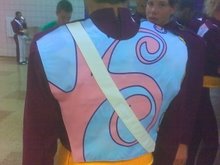The "Broken Windows" theory of marching bands.
The "Broken Windows" theory of crime was first put forth in 1982 by James Wilson and George Kelling. Crime rates at that time were through the roof and scholars were seeking some type of explanation. Criminal Psychology at the time was almost entirely focused on crime as a function of violent, individual, anti-social behavior. In short, people committed crimes because they were criminals.
Wilson and Kelling were some of the first scholars to theorize that crime had a basis in environmental factors, not simply individual behaviors. The "Broken Windows" theory speculated that perceived decadence in a neighborhood is a major contributing factor to crime. They used the example of a neighborhood with a few broken windows. If the windows go unfixed, it sends a signal that 1.) people do not care about things such as that in the neighborhood, and 2.) there is most likely no consequences for minor vandalism. This view of a decadent environment is extrapolated and projected into other situations throughout the neighborhood creating crime of ever increasing magnitude - in other words; minor infractions beget major crime.
The City of New York decided to heed the advice of criminologists subscribing to this theory and by the mid 90's, crime was at the lowest rate in 20 years.
Now, how does this relate to marching band?....
It is quite simple - the details and small things are the foundation of a successful band program. Many directors stress over the big picture too often - rehearsal times, show concepts, uniforms, guard flags -while letting the seemingly insignificant things fall through the cracks. They think of the program in terms of the giant pieces - if they could just get the right giant pieces in place they could make a great program. It is like an construction worker thinking only of giant steel beams and oceans of concrete while ignoring the mortar and rivets that hold everything together. Truth is, all buildings are made of essentially the same big materials, what makes them different are the details of how things fit together.
Practically this means that instead of focusing on how much rehearsal time is scheduled, maybe you should focus on starting on time and following a schedule? Rehearsals that do not start on time send the same message as a broken window in a bad neighborhood. Students will begin to expect a late start and the line between free time and rehearsal time will be perceived as being blurred. As a director, you must make sure to mend the broken window as quickly as possible to send a message that these things will not be tolerated.
As for schedules, a giant broken window that many groups create is ignoring them. If students and staff expect schedules to be inaccurate, they lose all meaning and thus the goals set out in the schedule lose meaning as well. Make sure everyone knows the schedule ad be very rigid in sticking to it and the goals for the rehearsal.
Rehearsal scheduling is just one facet of the program that a good director cannot ignore. There are many other "windows" out there that a director must keep an eye on to prevent minor infractions from snowballing. These include:
1. Keeping the band room/equipment room(s) clean and organized. The worse state the rooms are in, the easier it is for students and staff to justify perpetuating it. If everyone expects cleanliness and order, they will most likely do things to preserve it.
2. Making sure instruments are in good workable condition. This is a huge budget issue, but if students do not have quality instruments in their hands, they perceive disorder and decadence in the program and will perpetuate it.
3. Proper Attendance and Absence requests. This seems like a no brainer but you would be surprised to find out how many directors fail to take accurate attendance or have official means of student absence requests. Making sure to do this is not only a way of asserting control over the group, but also makes students accountable for their time.
4. Always fight to make sure the band has the best. This means fighting to get lighted fields; or more paint to keep the fields lined; or enough paper to copy drill for every member; making sure the band is fed on long days; getting nice buses; clean uniforms; and much, much more. Basically, if you give the perception that the band is getting the best, then students are more likely to give you their best.
I implore all directors to take a look at what is going on in their band program and scrutinize how you deal with small things that may come your way. Sometimes the smallest things can be the most important to a great band program. ![]() drum corps ;
drum corps ; ![]() DCI ;
DCI ; ![]() marching band
marching band
Continue reading...




